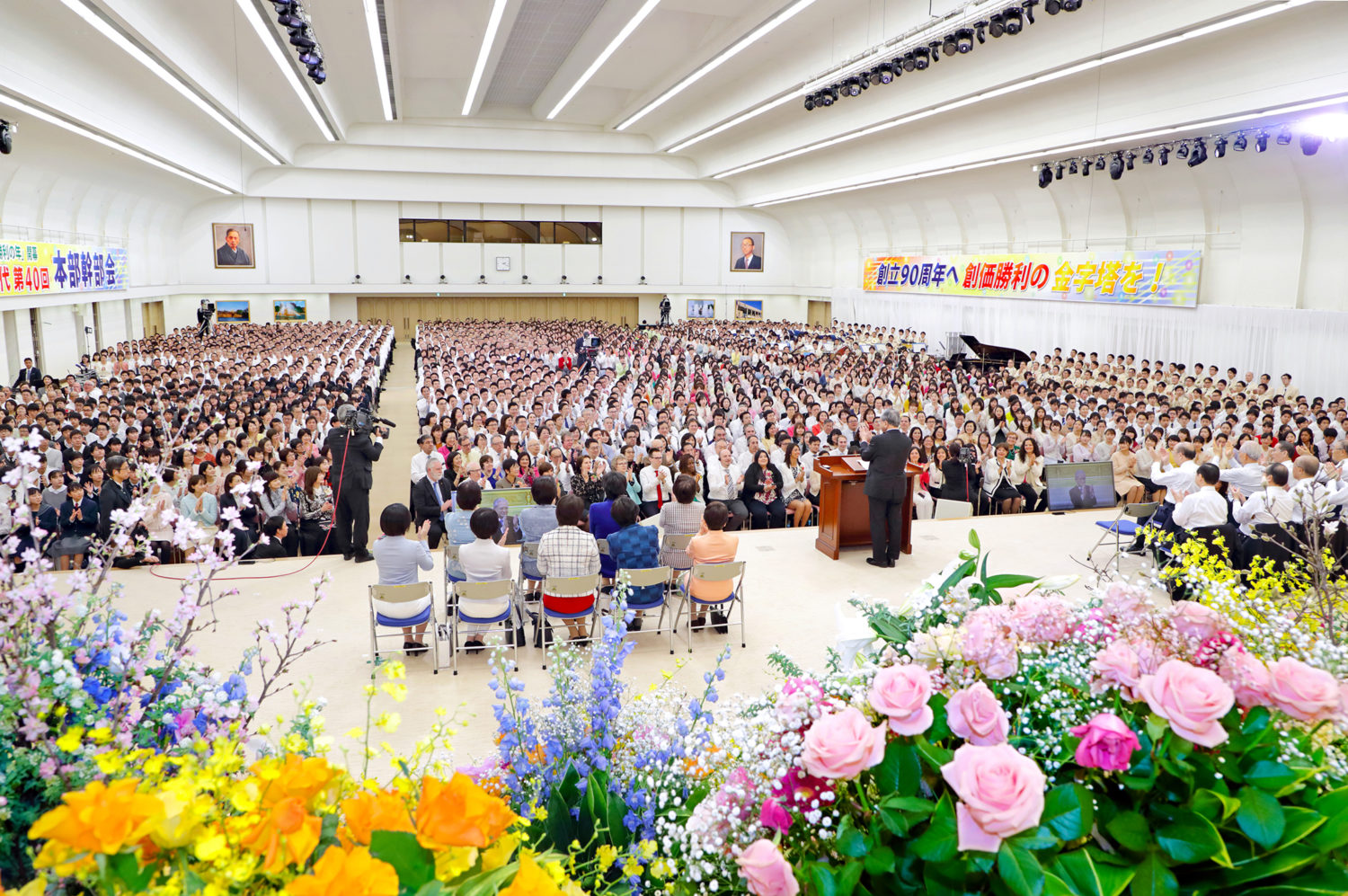The following is an excerpt of Soka Gakkai President Minoru Harada’s speech on Jan. 12, 2019, during the 40th Soka Gakkai Headquarters Leaders Meeting, held at the Tokyo Toda Memorial Auditorium. The text appeared in the Jan. 18 issue of the Seikyo Shimbun, the Soka Gakkai’s daily newspaper.
Congratulations on holding this 40th Headquarters Leaders Meeting of the New Era of Worldwide Kosen-rufu to launch our journey toward our 90th anniversary in 2020!
Today, we are also joined by 123 SGI representatives from 14 countries and territories. Welcome, and thank you for traveling great distances.
First of all, I would like to offer my deepest appreciation to the members of the financial contribution group for your sincere efforts during our contribution period at the end of last year. Thank you very much.
Disciples Taking Full Responsibility for Kosen-rufu
Heralding the start of this Year of Soka Victory—Toward Our 90th Anniversary, SGI President Ikeda sent a message to our New Year’s gongyo meetings. Accompanying his message, he sent the following poem:
As mentor and disciple,
let’s together celebrate
our coming victories
This reminds me of the poem he penned commemorating the 20th anniversary of the start of The New Human Revolution, which reads:
As mentor and disciple,
let’s together achieve
a brilliant human revolution
With the completion of The New Human Revolution [Sept. 8, 2018], the time has come for us as disciples to take full responsibility for achieving kosen-rufu. Our campaigns this year will kick off this endeavor.
Let’s resolutely win in every struggle and joyfully celebrate many new victories as mentor and disciple.
The construction of the new Seikyo Shimbun headquarters, which will be named the Soka Gakkai World Seikyo Center, is in full swing toward its opening in November this year. The very first time the phrase human revolution appeared in the Seikyo Shimbun was in its inaugural April 20, 1951, issue, with the start of the serialized novel The Human Revolution. This was written by second Soka Gakkai President Josei Toda and later published as a book in 1957.
That year, when Daisaku Ikeda was called to Osaka during the Osaka Incident, Mr. Toda met him at Tokyo’s Haneda Airport.
He handed him a book, saying: “Daisaku, the book has finally been published. Please read it.” This was The Human Revolution, which had just been published a few days earlier. President Ikeda read the novel in earnest during his flight and landed in Osaka, fully prepared to face the devilish nature of authoritarianism.
Chant Nam-myoho-renge-kyo Powerfully
President Toda titled the afterword of his novel “The Essence of Human Revolution,” writing that family revolution or financial revolution is but one perspective of Nichiren Buddhism.
“True human revolution,” he writes, “still lies ahead of us.” He continues, “My cherished wish is that you fight courageously against the three powerful enemies, vanquish the three obstacles and the four devils, and experience the true great benefit of faith and the essence of human revolution.”
That is to say, true human revolution lies in faith based on battling the three powerful enemies and defeating the three obstacles and four devils.
When we study Nichiren Daishonin’s life, it is clear that the three powerful enemies and the three obstacles and four devils began assailing him from the moment he submitted his treatise “On Establishing the Correct Teaching for the Peace of the Land” and remonstrated with governmental authorities.
He states, “I say all this solely for the sake of the nation, for the sake of the Law, for the sake of others, not for my own sake” (“The Rationale for Writing ‘On Establishing the Correct Teaching for the Peace of the Land,’ ” The Writings of Nichiren Daishonin, vol. 1, p. 164). In other words, the spirit of “Establishing the Correct Teaching for the Peace of the Land” is not about the happiness of just one individual. Rather, it’s about engaging in dialogue to share Buddhism with others so that they, too, can attain happiness. In fact, I would like to clarify that the true path toward achieving one’s human revolution lies in this point of working for the happiness of others.
It is the method President Ikeda employed in his actions during the historical Osaka Campaign and the ensuing Osaka Incident.
In a Seikyo Shimbun article published this year on Jan. 5, he introduced two passages from Nichiren Daishonin’s writings that he had shared on Jan. 5, 1956, at a district leaders meeting marking the actual start of the Osaka.
In this year’s article, Sensei called on us, saying, “I hope we will all engrave [these passages] in our hearts again at the start of this new year.” And he introduced the following passages:
I am praying that, no matter how troubled the times may become, the Lotus Sutra and the ten demon daughters [guardian deities of Buddhism] will protect all of you, praying as earnestly as though to produce fire from damp wood, or to obtain water from parched ground. (“Rebuking Slander of the Law,” WND-1, 444)
• • •
Employ the strategy of the Lotus Sutra before any other. (“The Strategy of the Lotus Sutra,” WND-1, 1001)
Deeply engraving these passages in our lives, let’s resolutely challenge and remain undaunted no matter how turbulent or chaotic the times, employing the strategy of the Lotus Sutra and always basing our lives on faith.
And let’s strive to fulfill our vow to positively transform our place of mission into a beautiful realm of lasting peace and prosperity!
You are reading {{ meterCount }} of {{ meterMax }} free premium articles

